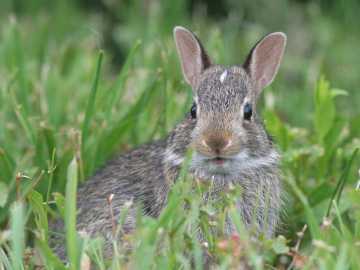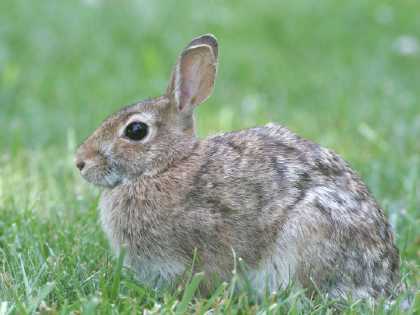

PHOTO COURTESY OF GARRY KESSLER
This baby cottontail is no bigger than the short grass in a lawn. The white spot on its forehead gives it away as an Eastern cottontail rather than a native New England cottontail. Eastern cottontails are native to North America but were brought to New England from the Midwest. They are now far more common here than the New England cottontails that were plentiful in Massachusetts a hundred years ago.
June 23, 2006, Page 18, 19
NATURE NOTES
By ANNIE REID
Westborough Community Land Trust
The tale of the cottontail rabbit
June's long summer evenings and fresh early mornings are fine times to spot a cottontail rabbit as it hops away, zigzagging to safety in the brush, either in your own back yard or an open area along a Charm Bracelet trail.
A cottontail rabbit that you see in Westborough is most likely an Eastern cottontail (
Sylvilagus floridanus), which is native to the Midwest, rather than a native New England cottontail (
Sylvilagus transitionalis).
Both rabbits look very similar, but Eastern cottontails have become common here since they were introduced in New England starting in the 1920s. The number of New England cottontails has declined dramatically since the 1960s.
What has happened? Wildlife biologists aren't sure. One possibility is that Eastern cottontails are better at avoiding predators, such as coyotes, foxes, hawks, and owls. They have bigger eyes and better eyesight than New England cottontails, so they see danger sooner. For example, an Eastern cottontail can spot a predator at 70 feet, but a New England cottontail only notices it at 30 feet.
With their superior ability to detect predators, Eastern cottontails can venture farther into the open for food and still have time to scamper for cover when danger approaches. New England cottontails need to stay close to dense cover to survive. This difference may give Eastern cottontails an edge in adapting to the varied landscape in New England today, with its mix of forest, farms, and suburbs.
Look for cottontails around dawn and dusk. They frequent grassy areas – including lush lawns with clover and dandelions – near shrubs, hedges, brush piles, or stone walls that offer good cover. The entrance to the Bowman Conservation Area from the parking lot on Bowman Street is a good example of the type of area that cottontails like. One was actually spotted there late on Easter Sunday this year.

PHOTO COURTESY OF GARRY KESSLER
A full-grown Eastern cottontail freezes in place so no movements will help a predator to zero in on it. With their large eyes, Eastern cottontails see farther than New England cottontails. This makes them better at spotting and avoiding predators, including hawks, owls, foxes, coyotes, and even neighborhood dogs and cats.
Although cottontails are active year-round, we notice them in the summer months, perhaps because more of them are around. Their breeding season lasts from April through September, and rabbits are, after all, notorious for producing lots of young. The adults mate but don't pair up.
Female cottontails make a nest for their young by scraping a shallow depression in soft ground and lining it with grass and their own fur. The young are born helpless, covered only with fine hair and with eyes closed. The mother nurses them twice a day but otherwise stays out of the nest. The young start venturing out of the nest at two weeks and are independent at five weeks.
Each season female cottontails in our area typically have three litters of four or five young. In the case of Eastern cottontails, the young from the first litter start to reproduce by summer's end. So if that Easter bunny at the Bowman Conservation Area was female, she can add 25 bunnies – or more – to the local population this year.
To do the math, figure that she has three litters of five each, producing 15 young. If half of her first litter are females, then figure two or three females from that first litter have their own litters of five each, producing another 10 or 15. That adds up to 25-30 new rabbits.
So why aren't we overrun with cottontails? Rabbits may be famous for their reproductive rate, but they're just as famous as prey. They're said to be the most preyed-upon animals in North America. They are food for meat-eaters who can't survive on plants as rabbits do. Cottontails are also vulnerable to diseases, parasites that weaken them, and severe weather. Heavy rains can drown newborns in their nest.
Young rabbits are especially likely to become a meal. About half of this year's new rabbits will live to be four months old. Only 10-20 percent will make it to spring. Those odds mean that only 3 to 6 of this summer's descendents from our Bowman Conservation Area Easter bunny are likely to see next Easter. Predation and other hazards do a pretty good job of offsetting the cottontail's prolific reproduction.
Cottontails survive as well as they do partly because they eat a great variety of plants. In the summer they munch all sorts of green plants, including our lawns and gardens. They often follow regular routes as they forage, so you can watch for them in the same places at similar times. In the fall they eat berries and canes of brambles. Cottontails also eat their own pellets, giving their digestive system a second chance to take nutrients out of their food.
In winter cottontails survive on bark, buds, and twigs. They find shelter in tunnels and borrows dug by other animals, such as woodchucks. You may see their tracks in the snow or signs of their gnawing. They make clean, angled cuts on stems and twigs, no more than 2-1/2 feet above the snow.
To keep cottontails out of your vegetable garden, use a 3-foot fence with 1- or 2-inch mesh. They're not good at digging or climbing. To prevent them from slipping under the fence where another animal digs, extend the fence one foot under ground.
From Peter Rabbit to Roger Rabbit, from Bugs Bunny to the Easter Bunny, from Playboy bunnies to the Energizer bunny, rabbits populate our stories and capture our imaginations with memorable characters. In folklore and popular culture, rabbits are associated with fertility, innocence and clever trickery as a survival skill.
Rabbits also find a place in other cultures. In Japan, people look at the moon and see a rabbit, not the man in the moon. The Chinese zodiac includes a rabbit, and one of every twelve years in the traditional Chinese calendar is the year of the rabbit. Some Native American tribes have a rabbit god in their mythology.
Domesticated rabbits are European rabbits (
Oryctolagus cuniculus). These rabbits are kept as pets, raised for meat or fur, and used as laboratory animals.
Nature Notes is printed in The Westborough News on behalf of WCLT (Westborough Community Land Trust).
Report your own local nature sightings (or check out what others have seen) on WCLT's Facebook page!
Find more information about enjoying nature in Westborough, including trail maps and a calendar of events, at the WCLT website.


